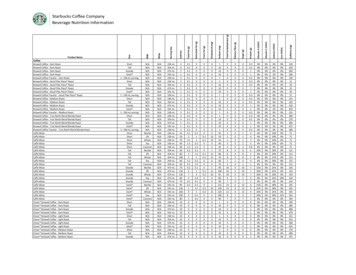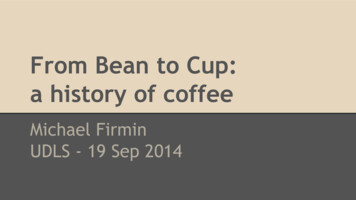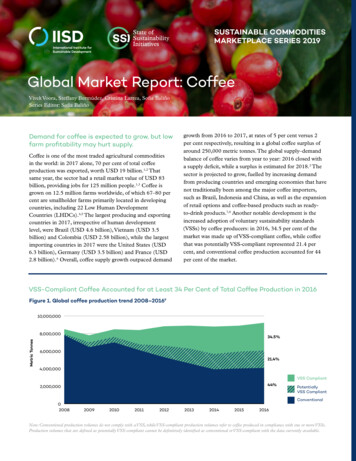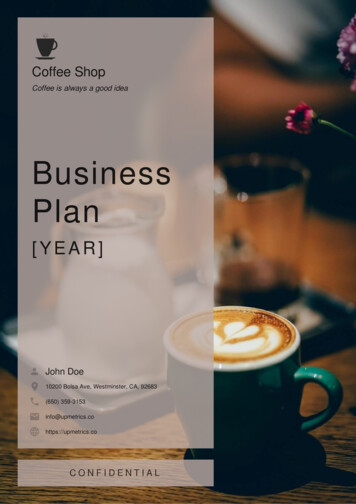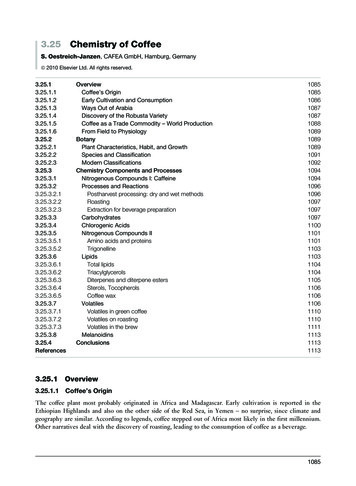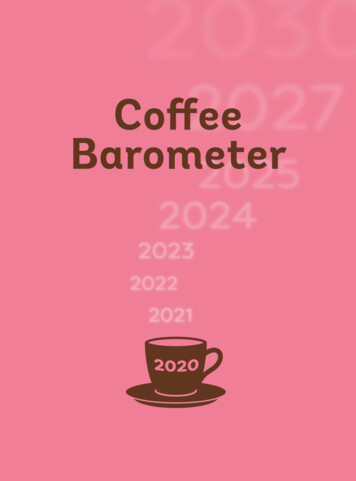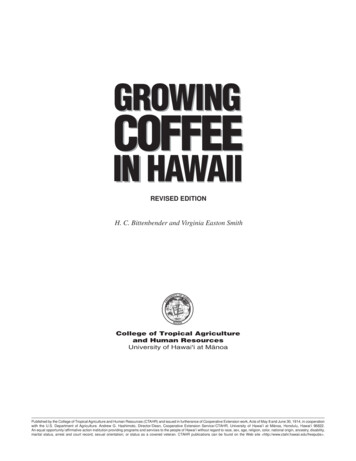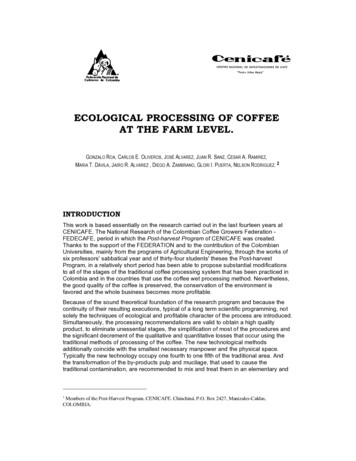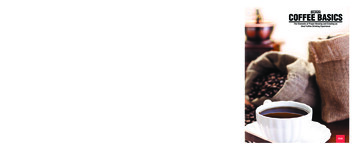
Transcription
Coffee termsbunn technology gives you controlSolids in the BrewDuring the brew process the watersoluble materials (solids) dissolveand move out of the coffee groundsand into the water. The level ofsolids changes while brewing,effecting the flavor, color, body andaroma of the coffee.Brew TimeWe manage the science of brewing so you don’t have to. BUNN offers a line ofprecision brewing and serving systems that are designed to produce optimum flavor.The machine matters!The sprayhead dispenses hot water and then turnsoff, allowing the wetting phase to complete.Pre-infusion ensures that the coffee will be readyfor the extraction phase when the sprayhead turnsback on.PhasePulse brew: Control over the extraction phaseHigh Solids(Best flavor and least bitterness)The sprayhead dispenses hot water then goesthrough a cycle of turning off and back on. Pulsebrew enables you to adjust the flavor of your coffeeby extending brew times.2ndVariable Bypass: Control over brew strengthBypassing a percentage of the water around theground coffee allows you to create unique flavors.Digital Temperature: Control over brew temperatureWith Digital Brewer Control, you have the option toset the brewing temperature precisely where youwant it. The low temperature brew lock-out featureensures adequate water temperature.Extraction Systems: Control over water distributionFrom traditional BUNN sprayhead designs to theBUNN 21-hole sprayhead, you can choose thespray pattern that yields the ideal flavor for yourtaste profile.Brewed coffee should be enjoyed while flavor and aroma are at their peak. BUNN offersa range of holding and serving equipment designed to keep your coffee at its best.(Least acids)Most volatile aromatics in coffee have boiling pointswell below that of water and continue to evaporatefrom the surface until pressure in the servingcontainer reaches equilibrium. A closed containercan slow the process of evaporation.PhaseIdeal serving temperature: 155ºF to 175ºFLow Solids / Low pH(Most bitterness and astringency)This is why coffee should neverbe served before the brewingprocess is completed! All threephases combine to produce theideal flavor.Volatile aromatics in coffee are not perceived whencoffee is served at lower temperatures.The terms used to describe the characteristics of the coffee drinking experience are:Fragrance: Sometimes confused with aroma, this is the smell of ground coffee before the addition of water.Aroma: The gases that evaporate as ground coffee is exposed to water.Flavor: The liquids that are responsible for the overall taste of coffee.Acidity: The taste of coffee that creates differing sensations on certain areas of the tongue.Body: The solids that determine the way coffee feels in your mouth.Aftertaste (or Finish): The lingering remnant of taste after the coffee is swallowed that often changes over time.BUNN Programming FEaturesBrewLOGIC Easy programming compensates for flow rate variations to ensure consistent dispense levels whenwater quality is a consideration.BrewWISE , Smart Funnel and Smart Hopper Features RFID communications between grinder, funnel, andbrewer, managing the brewing process from start to finish consistently and without error.BrewWISE Recipe Writer Unique information storage and transfer media dramatically reduces brewer programmingtimes and input errors.BrewWIZARD Easy access to the most used setup parameters, including a lock-out feature to prevent brewing if thewater is less than ready temperatureSmartWAVE A BUNN exclusive design that uses technology to increase turbulence in the brew funnel, providingmore contact time between water and coffee and uniformity of extraction.Others include: Language/Units, Temperature, Freshness Timer, Advertising, Sanitation Timer, Recipe Cards,Service & Asset Numbers, and Brew CountersRESPECTIdeal holding time: 20 minutes in an open topdecanter / 60 minutes in a closed containerHolding coffee longer will result in loss of thesmooth, sweet and complex flavors and insteadproduce a scorched or bitter taste.E9000.0008CCoffee Basics Bochure SCAA 10-28-11.indd 3Non-volatiles: Soluble materials that do not evaporate, but stay in solution.BrewMETER Simplifies pulse brew and allows extraction manipulation with the touch of a button.Ideal holding temperature: 175ºF to 185ºF3rdThe Elements of Proper Brewing and Creating anIdeal Coffee Drinking ExperienceVolatiles: Soluble materials that evaporate easily.See other BUNN programming featureson the back panelholding and serving know howPhaseAverage SolublesSoluble Materials: Compounds that dissolve in water.COFFEE BASICSNon-soluble Materials: Compounds that do not dissolve in water.Equipment featuring Digital Brewer Control gives the operator control of the brewing processto create a variety of coffee recipes from a singleorigin of bean, or perfect recipes for different blendsof beans.Pre-infusion: Control over the wetting process1stThe process of running hot water through coffee removes various materials from the grind. Thosematerials are:10/11 2011 Bunn-O-Matic CorporationBUNN is committed to environmental stewardship and continually strives to incorporatea respect for natural resources into our daily business practices and products. Thisbrochure is printed on paper using 30% post-consumer waste.EARTH 1400 Stevenson Drive, Springfield, IL 62703 USA800-637-8606 217-529-6601 www.BUNN.comSCAA11/4/11 11:10 AM
THE ELEMENTS OF Proper BREWINGWATERBUNN offers a complete line of commercial-grade water quality filtration systems for use with BUNNcommercial brewing equipment to ensure customers are getting the best tasting beverage possible.The brewing time, or thetime water is in contact withcoffee grind, determines theamount of coffee materialextracted. This is the majorcomponent affecting flavor.COFFEE BREWING CONTROL CHARTTEMPERATUREThe temperature of the water during brewingaffects flavor and extraction. Ideal Water Temperature – 195º - 205ºFHigher temperatures may result in undesirablecoffee flavor and lower temperatures will resultin poor extraction.The grounds begin to absorb the hot water from the sprayhead and release gasses from the coffee. Forconsistent extraction from all parts of the coffee grounds, the entire bed of coffee must be evenly wet in thefirst 10% of the brew cycle time.ExtractionHigh SolidsAverage SolublesLow Solids / Low pH(Best flavor andleast bitterness)(Least acids)(Most bitternessand astringency)HydrolysisThrough this chemical reaction, thematerials created during extractionbreak down further into watersoluble proteins and sugars.BREW CYCLE TIME1st PhaseTURBULENCETurbulence is created asthe water passes throughand over the coffee. Itshould cause the particlesto separate and create auniform flow of water aroundthem for proper extraction.Paper filters produce the clearestcup of coffee. BUNN filters are: Porous enough to allow free flow of theextracted coffee solubles.The brewing or water contact time with the coffee grounds is primarily determined by the grind size and beddepth. A longer brew time is required for the water to penetrate the larger grind particles. The recommendedbrewing contact times for each grind size are shown here.1 Water Reservoir/PitcherNever clean with a steel wool or other abrasives which can cause flaking or scratching which canlead to further pitting, corrosion and deposits.Coffee Basics Bochure SCAA 10-28-11.indd 22345678General Guidline: The finer the grind, the shorter the time. ServersBrewing Ratio Ounces of Ground Coffee per Half-gallonThe red diagonal lines represent brewingratios of ground coffee used per halfgallon of water. The ground coffeemeasurements are displayed in ouncesacross the top and down the right side ofthe Chart.Strength (Solubles Concentration)Approximately one-fourth to one-thirdof a roasted coffee bean is matter thatwill readily dissolve in water during thebrewing process. The other portionis bean fiber that isn’t soluble duringnormal brewing. The bottom of the Chartconverts the fraction of the original dryground coffee that has ended up in thefinished cup to a percentage. The idealrange is 18% to 22% of the solubles.Grind size and brew time play a criticalpart in extraction.Optimum BalanceBalancing strength and extractionproduces a standard designated as“Golden Cup” by the Specialty CoffeeAssociation of America.USING THE CHART Strong enough to prevent collapsing.CLEANLINESS Sprayhead/Funnel3rd PhaseMATCH THE GRIND TO BREW TIMEThe paper stock used in manufacturingBUNN filters is produced using an elementalchlorine-free method. Serving area2nd Phase Perfect for coffees requiring exact brewing,like decaf and flavored coffees.Make sure everything related to coffee brewing and serving is clean and free from limeand hard water deposits. Specifically, assure the following are spotlessly clean:According to this chart developed through years of research and testing and now used by the SpecialtyCoffee Association of America, every great cup of coffee has three important variables—strength, extractionand brewing ratio. By plotting the relationship between these factors, it is possible to produce the idealcoffee flavor and drinking experience.Extraction (Solubles Yield)Contact/brew time should never exceed 8 minutes.FILTRATIONBrewing RatioThe left side of the Chart indicatesstrength as a percentage. Other ControlCharts may include total dissolved solids(TDS). The ideal percentage of coffeeflavoring material in the finished cup is1.15% to 1.35%, and is most accuratelymeasured by a Brew Strength Meter,hydrometer or refractometer.The water-soluble materialsdissolve and move out of the coffeegrounds and into the water. Thebest flavors are extracted at thebeginning of the process as seen inthe Brew Cycle Time table.TASTEMineral content can affect taste. For best results, water should never be artificiallysoftened and should not exceed the following parts per million (ppm) of dissolvedminerals: Ideal – 50-100 ppm (50-100 mg/L) or 3 to 6 grains of hardness Acceptable – Below 300 ppm (300 mg/L) or 18 grains of hardnessTIMETHE TECHNIQUE OF BREWING CONTROLWettingFresh, good-tasting water is essential since it makes up more than 98 percent of a cupof coffee.THE SCIENCE OF THE BREWING PROCESSBrewer Cycle TimingBed DepthThe brew cycle delivery time of a coffee brewerassists in determining the recommended coffeegrind to produce a quality cup. Experimenting with acoarser or finer grind will help operators discover thepreferred coffee flavor profile.The ideal depth of the coffee bed in the brew basketis 1-2 inches regardless of the volume of brew. If acoffee bed is less than 1 inch, the water may movethrough it too quickly and under-extract. Water movingtoo slowly through a bed depth of more than 2 inchesmay cause over-extraction and a bitter taste.By using the weight of ground coffee inthe brew basket, the volume of waterused, and the strength of the brewedcoffee, you can plot these to determinethe extraction. The objective is to getto the Optimum Balance area. If youuse 4 oz. of coffee and the strength ofthe brew was determined to be 1.40%,follow the red line labeled 4.00 oz downthe red diagonal to the 1.40% grid line,and then straight down vertically to thebottom of the chart to extraction which isapproximately 20.5%. Even though theextraction falls within the ideal range, thiscoffee is STRONG. To move the outcome,extraction needs to decrease to 18% 19.8% by decreasing the brew time and/or increasing the grind size.11/4/11 11:10 AM
THE ELEMENTS OF Proper BREWINGWATERBUNN offers a complete line of commercial-grade water quality filtration systems for use with BUNNcommercial brewing equipment to ensure customers are getting the best tasting beverage possible.The brewing time, or thetime water is in contact withcoffee grind, determines theamount of coffee materialextracted. This is the majorcomponent affecting flavor.COFFEE BREWING CONTROL CHARTTEMPERATUREThe temperature of the water during brewingaffects flavor and extraction. Ideal Water Temperature – 195º - 205ºFHigher temperatures may result in undesirablecoffee flavor and lower temperatures will resultin poor extraction.The grounds begin to absorb the hot water from the sprayhead and release gasses from the coffee. Forconsistent extraction from all parts of the coffee grounds, the entire bed of coffee must be evenly wet in thefirst 10% of the brew cycle time.ExtractionHigh SolidsAverage SolublesLow Solids / Low pH(Best flavor andleast bitterness)(Least acids)(Most bitternessand astringency)HydrolysisThrough this chemical reaction, thematerials created during extractionbreak down further into watersoluble proteins and sugars.BREW CYCLE TIME1st PhaseTURBULENCETurbulence is created asthe water passes throughand over the coffee. Itshould cause the particlesto separate and create auniform flow of water aroundthem for proper extraction.Paper filters produce the clearestcup of coffee. BUNN filters are: Porous enough to allow free flow of theextracted coffee solubles.The brewing or water contact time with the coffee grounds is primarily determined by the grind size and beddepth. A longer brew time is required for the water to penetrate the larger grind particles. The recommendedbrewing contact times for each grind size are shown here.1 Water Reservoir/PitcherNever clean with a steel wool or other abrasives which can cause flaking or scratching which canlead to further pitting, corrosion and deposits.Coffee Basics Bochure SCAA 10-28-11.indd 22345678General Guidline: The finer the grind, the shorter the time. ServersBrewing Ratio Ounces of Ground Coffee per Half-gallonThe red diagonal lines represent brewingratios of ground coffee used per halfgallon of water. The ground coffeemeasurements are displayed in ouncesacross the top and down the right side ofthe Chart.Strength (Solubles Concentration)Approximately one-fourth to one-thirdof a roasted coffee bean is matter thatwill readily dissolve in water during thebrewing process. The other portionis bean fiber that isn’t soluble duringnormal brewing. The bottom of the Chartconverts the fraction of the original dryground coffee that has ended up in thefinished cup to a percentage. The idealrange is 18% to 22% of the solubles.Grind size and brew time play a criticalpart in extraction.Optimum BalanceBalancing strength and extractionproduces a standard designated as“Golden Cup” by the Specialty CoffeeAssociation of America.USING THE CHART Strong enough to prevent collapsing.CLEANLINESS Sprayhead/Funnel3rd PhaseMATCH THE GRIND TO BREW TIMEThe paper stock used in manufacturingBUNN filters is produced using an elementalchlorine-free method. Serving area2nd Phase Perfect for coffees requiring exact brewing,like decaf and flavored coffees.Make sure everything related to coffee brewing and serving is clean and free from limeand hard water deposits. Specifically, assure the following are spotlessly clean:According to this chart developed through years of research and testing and now used by the SpecialtyCoffee Association of America, every great cup of coffee has three important variables—strength, extractionand brewing ratio. By plotting the relationship between these factors, it is possible to produce the idealcoffee flavor and drinking experience.Extraction (Solubles Yield)Contact/brew time should never exceed 8 minutes.FILTRATIONBrewing RatioThe left side of the Chart indicatesstrength as a percentage. Other ControlCharts may include total dissolved solids(TDS). The ideal percentage of coffeeflavoring material in the finished cup is1.15% to 1.35%, and is most accuratelymeasured by a Brew Strength Meter,hydrometer or refractometer.The water-soluble materialsdissolve and move out of the coffeegrounds and into the water. Thebest flavors are extracted at thebeginning of the process as seen inthe Brew Cycle Time table.TASTEMineral content can affect taste. For best results, water should never be artificiallysoftened and should not exceed the following parts per million (ppm) of dissolvedminerals: Ideal – 50-100 ppm (50-100 mg/L) or 3 to 6 grains of hardness Acceptable – Below 300 ppm (300 mg/L) or 18 grains of hardnessTIMETHE TECHNIQUE OF BREWING CONTROLWettingFresh, good-tasting water is essential since it makes up more than 98 percent of a cupof coffee.THE SCIENCE OF THE BREWING PROCESSBrewer Cycle TimingBed DepthThe brew cycle delivery time of a coffee brewerassists in determining the recommended coffeegrind to produce a quality cup. Experimenting with acoarser or finer grind will help operators discover thepreferred coffee flavor profile.The ideal depth of the coffee bed in the brew basketis 1-2 inches regardless of the volume of brew. If acoffee bed is less than 1 inch, the water may movethrough it too quickly and under-extract. Water movingtoo slowly through a bed depth of more than 2 inchesmay cause over-extraction and a bitter taste.By using the weight of ground coffee inthe brew basket, the volume of waterused, and the strength of the brewedcoffee, you can plot these to determinethe extraction. The objective is to getto the Optimum Balance area. If youuse 4 oz. of coffee and the strength ofthe brew was determined to be 1.40%,follow the red line labeled 4.00 oz downthe red diagonal to the 1.40% grid line,and then straight down vertically to thebottom of the chart to extraction which isapproximately 20.5%. Even though theextraction falls within the ideal range, thiscoffee is STRONG. To move the outcome,extraction needs to decrease to 18% 19.8% by decreasing the brew time and/or increasing the grind size.11/4/11 11:10 AM
THE ELEMENTS OF Proper BREWINGWATERBUNN offers a complete line of commercial-grade water quality filtration systems for use with BUNNcommercial brewing equipment to ensure customers are getting the best tasting beverage possible.The brewing time, or thetime water is in contact withcoffee grind, determines theamount of coffee materialextracted. This is the majorcomponent affecting flavor.COFFEE BREWING CONTROL CHARTTEMPERATUREThe temperature of the water during brewingaffects flavor and extraction. Ideal Water Temperature – 195º - 205ºFHigher temperatures may result in undesirablecoffee flavor and lower temperatures will resultin poor extraction.The grounds begin to absorb the hot water from the sprayhead and release gasses from the coffee. Forconsistent extraction from all parts of the coffee grounds, the entire bed of coffee must be evenly wet in thefirst 10% of the brew cycle time.ExtractionHigh SolidsAverage SolublesLow Solids / Low pH(Best flavor andleast bitterness)(Least acids)(Most bitternessand astringency)HydrolysisThrough this chemical reaction, thematerials created during extractionbreak down further into watersoluble proteins and sugars.BREW CYCLE TIME1st PhaseTURBULENCETurbulence is created asthe water passes throughand over the coffee. Itshould cause the particlesto separate and create auniform flow of water aroundthem for proper extraction.Paper filters produce the clearestcup of coffee. BUNN filters are: Porous enough to allow free flow of theextracted coffee solubles.The brewing or water contact time with the coffee grounds is primarily determined by the grind size and beddepth. A longer brew time is required for the water to penetrate the larger grind particles. The recommendedbrewing contact times for each grind size are shown here.1 Water Reservoir/PitcherNever clean with a steel wool or other abrasives which can cause flaking or scratching which canlead to further pitting, corrosion and deposits.Coffee Basics Bochure SCAA 10-28-11.indd 22345678General Guidline: The finer the grind, the shorter the time. ServersBrewing Ratio Ounces of Ground Coffee per Half-gallonThe red diagonal lines represent brewingratios of ground coffee used per halfgallon of water. The ground coffeemeasurements are displayed in ouncesacross the top and down the right side ofthe Chart.Strength (Solubles Concentration)Approximately one-fourth to one-thirdof a roasted coffee bean is matter thatwill readily dissolve in water during thebrewing process. The other portionis bean fiber that isn’t soluble duringnormal brewing. The bottom of the Chartconverts the fraction of the original dryground coffee that has ended up in thefinished cup to a percentage. The idealrange is 18% to 22% of the solubles.Grind size and brew time play a criticalpart in extraction.Optimum BalanceBalancing strength and extractionproduces a standard designated as“Golden Cup” by the Specialty CoffeeAssociation of America.USING THE CHART Strong enough to prevent collapsing.CLEANLINESS Sprayhead/Funnel3rd PhaseMATCH THE GRIND TO BREW TIMEThe paper stock used in manufacturingBUNN filters is produced using an elementalchlorine-free method. Serving area2nd Phase Perfect for coffees requiring exact brewing,like decaf and flavored coffees.Make sure everything related to coffee brewing and serving is clean and free from limeand hard water deposits. Specifically, assure the following are spotlessly clean:According to this chart developed through years of research and testing and now used by the SpecialtyCoffee Association of America, every great cup of coffee has three important variables—strength, extractionand brewing ratio. By plotting the relationship between these factors, it is possible to produce the idealcoffee flavor and drinking experience.Extraction (Solubles Yield)Contact/brew time should never exceed 8 minutes.FILTRATIONBrewing RatioThe left side of the Chart indicatesstrength as a percentage. Other ControlCharts may include total dissolved solids(TDS). The ideal percentage of coffeeflavoring material in the finished cup is1.15% to 1.35%, and is most accuratelymeasured by a Brew Strength Meter,hydrometer or refractometer.The water-soluble materialsdissolve and move out of the coffeegrounds and into the water. Thebest flavors are extracted at thebeginning of the process as seen inthe Brew Cycle Time table.TASTEMineral content can affect taste. For best results, water should never be artificiallysoftened and should not exceed the following parts per million (ppm) of dissolvedminerals: Ideal – 50-100 ppm (50-100 mg/L) or 3 to 6 grains of hardness Acceptable – Below 300 ppm (300 mg/L) or 18 grains of hardnessTIMETHE TECHNIQUE OF BREWING CONTROLWettingFresh, good-tasting water is essential since it makes up more than 98 percent of a cupof coffee.THE SCIENCE OF THE BREWING PROCESSBrewer Cycle TimingBed DepthThe brew cycle delivery time of a coffee brewerassists in determining the recommended coffeegrind to produce a quality cup. Experimenting with acoarser or finer grind will help operators discover thepreferred coffee flavor profile.The ideal depth of the coffee bed in the brew basketis 1-2 inches regardless of the volume of brew. If acoffee bed is less than 1 inch, the water may movethrough it too quickly and under-extract. Water movingtoo slowly through a bed depth of more than 2 inchesmay cause over-extraction and a bitter taste.By using the weight of ground coffee inthe brew basket, the volume of waterused, and the strength of the brewedcoffee, you can plot these to determinethe extraction. The objective is to getto the Optimum Balance area. If youuse 4 oz. of coffee and the strength ofthe brew was determined to be 1.40%,follow the red line labeled 4.00 oz downthe red diagonal to the 1.40% grid line,and then straight down vertically to thebottom of the chart to extraction which isapproximately 20.5%. Even though theextraction falls within the ideal range, thiscoffee is STRONG. To move the outcome,extraction needs to decrease to 18% 19.8% by decreasing the brew time and/or increasing the grind size.11/4/11 11:10 AM
Coffee termsbunn technology gives you controlSolids in the BrewDuring the brew process the watersoluble materials (solids) dissolveand move out of the coffee groundsand into the water. The level ofsolids changes while brewing,effecting the flavor, color, body andaroma of the coffee.Brew TimeWe manage the science of brewing so you don’t have to. BUNN offers a line ofprecision brewing and serving systems that are designed to produce optimum flavor.The machine matters!The sprayhead dispenses hot water and then turnsoff, allowing the wetting phase to complete.Pre-infusion ensures that the coffee will be readyfor the extraction phase when the sprayhead turnsback on.PhasePulse brew: Control over the extraction phaseHigh Solids(Best flavor and least bitterness)The sprayhead dispenses hot water then goesthrough a cycle of turning off and back on. Pulsebrew enables you to adjust the flavor of your coffeeby extending brew times.2ndVariable Bypass: Control over brew strengthBypassing a percentage of the water around theground coffee allows you to create unique flavors.Digital Temperature: Control over brew temperatureWith Digital Brewer Control, you have the option toset the brewing temperature precisely where youwant it. The low temperature brew lock-out featureensures adequate water temperature.Extraction Systems: Control over water distributionFrom traditional BUNN sprayhead designs to theBUNN 21-hole sprayhead, you can choose thespray pattern that yields the ideal flavor for yourtaste profile.Brewed coffee should be enjoyed while flavor and aroma are at their peak. BUNN offersa range of holding and serving equipment designed to keep your coffee at its best.(Least acids)Most volatile aromatics in coffee have boiling pointswell below that of water and continue to evaporatefrom the surface until pressure in the servingcontainer reaches equilibrium. A closed containercan slow the process of evaporation.PhaseIdeal serving temperature: 155ºF to 175ºFLow Solids / Low pH(Most bitterness and astringency)This is why coffee should neverbe served before the brewingprocess is completed! All threephases combine to produce theideal flavor.Volatile aromatics in coffee are not perceived whencoffee is served at lower temperatures.The terms used to describe the characteristics of the coffee drinking experience are:Fragrance: Sometimes confused with aroma, this is the smell of ground coffee before the addition of water.Aroma: The gases that evaporate as ground coffee is exposed to water.Flavor: The liquids that are responsible for the overall taste of coffee.Acidity: The taste of coffee that creates differing sensations on certain areas of the tongue.Body: The solids that determine the way coffee feels in your mouth.Aftertaste (or Finish): The lingering remnant of taste after the coffee is swallowed that often changes over time.BUNN Programming FEaturesBrewLOGIC Easy programming compensates for flow rate variations to ensure consistent dispense levels whenwater quality is a consideration.BrewWISE , Smart Funnel and Smart Hopper Features RFID communications between grinder, funnel, andbrewer, managing the brewing process from start to finish consistently and without error.BrewWISE Recipe Writer Unique information storage and transfer media dramatically reduces brewer programmingtimes and input errors.BrewWIZARD Easy access to the most used setup parameters, including a lock-out feature to prevent brewing if thewater is less than ready temperatureSmartWAVE A BUNN exclusive design that uses technology to increase turbulence in the brew funnel, providingmore contact time between water and coffee and uniformity of extraction.Others include: Language/Units, Temperature, Freshness Timer, Advertising, Sanitation Timer, Recipe Cards,Service & Asset Numbers, and Brew CountersRESPECTIdeal holding time: 20 minutes in an open topdecanter / 60 minutes in a closed containerHolding coffee longer will result in loss of thesmooth, sweet and complex flavors and insteadproduce a scorched or bitter taste.E9000.0008CCoffee Basics Bochure SCAA 10-28-11.indd 3Non-volatiles: Soluble materials that do not evaporate, but stay in solution.BrewMETER Simplifies pulse brew and allows extraction manipulation with the touch of a button.Ideal holding temperature: 175ºF to 185ºF3rdThe Elements of Proper Brewing and Creating anIdeal Coffee Drinking ExperienceVolatiles: Soluble materials that evaporate easily.See other BUNN programming featureson the back panelholding and serving know howPhaseAverage SolublesSoluble Materials: Compounds that dissolve in water.COFFEE BASICSNon-soluble Materials: Compounds that do not dissolve in water.Equipment featuring Digital Brewer Control gives the operator control of the brewing processto create a variety of coffee recipes from a singleorigin of bean, or perfect recipes for different blendsof beans.Pre-infusion: Control over the wetting process1stThe process of running hot water through coffee removes various materials from the grind. Thosematerials are:10/11 2011 Bunn-O-Matic CorporationBUNN is committed to environmental stewardship and continually strives to incorporatea respect for natural resources into our daily business practices and products. Thisbrochure is printed on paper using 30% post-consumer waste.EARTH 1400 Stevenson Drive, Springfield, IL 62703 USA800-637-8606 217-529-6601 www.BUNN.comSCAA11/4/11 11:10 AM
Coffee termsbunn technology gives you controlSolids in the BrewDuring the brew process the watersoluble materials (solids) dissolveand move out of the coffee groundsand into the water. The level ofsolids changes while brewing,effecting the flavor, color, body andaroma of the coffee.Brew TimeWe manage the science of brewing so you don’t have to. BUNN offers a line ofprecision brewing and serving systems that are designed to produce optimum flavor.The machine matters!The sprayhead dispenses hot water and then turnsoff, allowing the wetting phase to complete.Pre-infusion ensures that the coffee will be readyfor the extraction phase when the sprayhead turnsback on.PhasePulse brew: Control over the extraction phaseHigh Solids(Best flavor and least bitterness)The sprayhead dispenses hot water then goesthrough a cycle of turning off and ba
Coffee Basics Bochure SCAA 10-28-11.indd 2 11/4/11 11:10 AM. Fresh, good-tasting water is essential since it makes up more than 98 percent of a cup of coffee. Mineral content can affect ta

